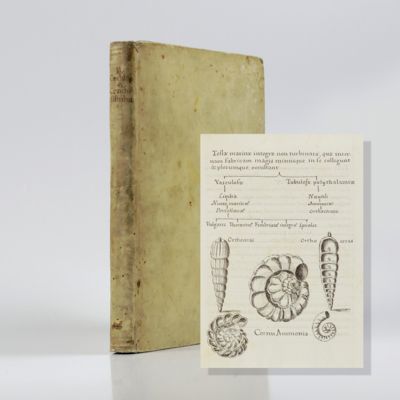A. B. [Unknown 18th-century Italian Malacologist]
Cochleae et conchae in sua genera distributae juxta methodum Tournefortii, Breynii, Gualterii, Charletton, & Anonymi Galli accedit index colorum Latino-italicus. Curante A. B.
Unpublished, ca. 1745. Folio (28.4 x 21.1 cm). Handwritten title page with calligraphed vignette. 155 pp. with handwritten text, and six blanks, not counting the endpapers; 35 illustrations. Contemporary full vellum. Script title in ink on the spine. Edges mottled red.
An amazingly well-preserved, beautifully illustrated and mysterious manuscript on the systematics of the Mollusca. The author compares the systems of Walter Charleton ( Onomasticon zoicon, published in 1668), Joseph Pitton de Tournefort (a manuscript text from about 1702), Johann Philipp Breyn ( Dissertatio physica de Polythalamiis, nova testaceorum classe, 1732), Niccolò Gualteri ( Index testarum conchyliorum,1742) and an "anonymous Frenchman", i.e. Dezallier d'Argenville ( l’Historie naturelle eclaircie dans deux de ses parties principales: la lithologie et la conchyliologie, 1742). Not listing Linnaeus implies that it was written before 1758; a time when uniformity in zoological descriptions became desired. A similar, more expanded work was written by Karl August de Bergen (1704-1759) and published in 1760. The inclusion of Joseph Pitton de Tournefort (1656-1708), in particular in reference to an unpublished manuscript, is peculiar. Principally known as an influential botanist, few works of his on invertebrate systematics are known, except for some observations on patelliform snails in his posthumously published Relation d'un voyage du Levant (1717). Here, he described and illustrated a few species such as Lepas; a genus name repeated in the manuscript in the same sense, thus not as a crustacean genus currently under that name. Gualtieri (1742) included Tournefort's system in his work, along his own, which is why we know Tournefort's work at all. The whereabouts of Tournefort's manuscript, or notebook, referred to in this manuscript, is unknown today. The manuscript ends with a novel alphabetical list of Latin words used to describe colours, in particular those of shells, with their translation into Italian. It is this list which strongly suggests that the manuscript is by an Italian writer. Most of the fine drawings are in the style of, and after Gualtieri. Some scattered, very mild, mostly marginal spotting, otherwise very good, clean. A unique, well-preserved item.




